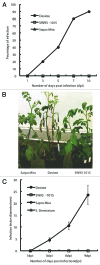Paranoid potato: phytophthora-resistant genotype shows constitutively activated defense
- PMID: 22476463
- PMCID: PMC3443922
- DOI: 10.4161/psb.19149
Paranoid potato: phytophthora-resistant genotype shows constitutively activated defense
Abstract
Phytophthora is the most devastating pathogen of dicot plants. There is a need for resistance sources with different modes of action to counteract the fast evolution of this pathogen. In order to better understand mechanisms of defense against P. infestans, we analyzed several clones of potato. Two of the genotypes tested, Sarpo Mira and SW93-1015, exhibited strong resistance against P. infestans in field trials, whole plant assays and detached leaf assays. The resistant genotypes developed different sizes of hypersensitive response (HR)-related lesions. HR lesions in SW93-1015 were restricted to very small areas, whereas those in Sarpo Mira were similar to those in Solanum demissum, the main source of classical resistance genes. SW93-1015 can be characterized as a cpr (constitutive expressor of PR genes) genotype without spontaneous microscopic or macroscopic HR lesions. This is indicated by constitutive hydrogen peroxide (H₂O₂) production and PR1 (pathogenesis-related protein 1) secretion. SW93-1015 is one of the first plants identified as having classical protein-based induced defense expressed constitutively without any obvious metabolic costs or spontaneous cell death lesions.
Figures





Similar articles
-
Revealing the importance of meristems and roots for the development of hypersensitive responses and full foliar resistance to Phytophthora infestans in the resistant potato cultivar Sarpo Mira.J Exp Bot. 2012 Aug;63(13):4765-79. doi: 10.1093/jxb/ers154. Epub 2012 Jul 27. J Exp Bot. 2012. PMID: 22844094 Free PMC article.
-
Effector-driven marker development and cloning of resistance genes against Phytophthora infestans in potato breeding clone SW93-1015.Theor Appl Genet. 2016 Jan;129(1):105-15. doi: 10.1007/s00122-015-2613-y. Epub 2015 Oct 30. Theor Appl Genet. 2016. PMID: 26518573
-
Differential gene induction in resistant and susceptible potato cultivars at early stages of infection by Phytophthora infestans.Plant Cell Rep. 2012 Jan;31(1):187-203. doi: 10.1007/s00299-011-1155-2. Epub 2011 Oct 2. Plant Cell Rep. 2012. PMID: 21965005
-
Genetic factors encoding resistance to late blight caused by Phytophthora infestans (Mont.) de Bary on the potato genetic map.Cell Mol Biol Lett. 2004;9(4B):855-67. Cell Mol Biol Lett. 2004. PMID: 15647802 Review.
-
Organization of genes controlling disease resistance in the potato genome.Annu Rev Phytopathol. 2001;39:79-102. doi: 10.1146/annurev.phyto.39.1.79. Annu Rev Phytopathol. 2001. PMID: 11701860 Review.
Cited by
-
Dual RNA-Sequencing of Eucalyptus nitens during Phytophthora cinnamomi Challenge Reveals Pathogen and Host Factors Influencing Compatibility.Front Plant Sci. 2016 Mar 2;7:191. doi: 10.3389/fpls.2016.00191. eCollection 2016. Front Plant Sci. 2016. PMID: 26973660 Free PMC article.
-
Comparative Transcriptome Profiling Reveals Compatible and Incompatible Patterns of Potato Toward Phytophthora infestans.G3 (Bethesda). 2020 Feb 6;10(2):623-634. doi: 10.1534/g3.119.400818. G3 (Bethesda). 2020. PMID: 31818876 Free PMC article.
-
Linking crop traits to transcriptome differences in a progeny population of tetraploid potato.BMC Plant Biol. 2020 Mar 18;20(1):120. doi: 10.1186/s12870-020-2305-x. BMC Plant Biol. 2020. PMID: 32183694 Free PMC article.
-
Evolutionary analysis of RB/Rpi-blb1 locus in the Solanaceae family.Mol Genet Genomics. 2015 Dec;290(6):2173-86. doi: 10.1007/s00438-015-1068-9. Epub 2015 May 26. Mol Genet Genomics. 2015. PMID: 26008792
-
Inoculation of Transgenic Resistant Potato by Phytophthora infestans Affects Host Plant Choice of a Generalist Moth.PLoS One. 2015 Jun 8;10(6):e0129815. doi: 10.1371/journal.pone.0129815. eCollection 2015. PLoS One. 2015. PMID: 26053171 Free PMC article.
References
-
- Haverkort A, Struik P, Visser R, Jacobsen E. Applied Biotechnology to Combat Late Blight in Potato Caused by Phytophthora Infestans. Potato Res. 2009;52:249–64. doi: 10.1007/s11540-009-9136-3. - DOI
-
- Griffith JM, Grant BR, Zhang QS. Role of Phosphatidic-Acid during Differentiation of Phytophthora-Palmivora Zoospores. J Gen Microbiol. 1992;138:451–9.
-
- Bolwell GP, Wojtaszek P. Mechanisms for the generation of reactive oxygen species in plant defence - a broad perspective. Physiol Mol Plant Pathol. 1997;51:347–66. doi: 10.1006/pmpp.1997.0129. - DOI
Publication types
MeSH terms
LinkOut - more resources
Full Text Sources
Research Materials
